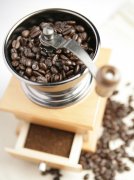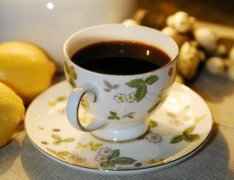Boutique Coffee General knowledge of Coffee Arabica vs Robsta
In many places where coffee is sold, it is not difficult to find words like "100% Arabica", and even canned coffee has a style called "XX Arabica Coffee", which makes one wonder: What is "Arabica Coffee"?

In fact, Arabica is the name of the coffee tree species.
Coffea Arabica and Coffea Robusta are two distinct coffee varieties that currently account for the majority of coffee bean production worldwide. There are three main differences between Arabica coffee and Robusta coffee: 1. 2. Flavors differ. 3. Difference between market value and use.
Differences in planting conditions
Arabica coffee is grown under harsher conditions, requiring higher altitudes (600 to 2000 meters above sea level), fertile soil, adequate moisture, proper sunlight and shade. Arabica coffee trees are less resistant to pests and diseases and are vulnerable to damage. In addition, the annual yield of coffee trees per unit area is also low.
Arabica coffee currently accounts for 75% of the world's coffee production, and only 10% of this Arabica coffee production can be classified as "Specialty Coffee".
Robusta coffee, commonly known as "robust beans", can be grown at low altitudes (200 to 800 meters above sea level), is resistant to pests and diseases, is not susceptible to agricultural damage, has a high annual yield per unit area of coffee trees, is harvested by machines, and generally, the production cost is much lower than Arabica coffee.
Different flavor characteristics
"Arabica" coffee has a variety and a wide range of potential flavors. Arabica coffee produced in different regions, at different altitudes and in different climates usually has its own characteristics and can show very different personality flavors. "Arabica" coffee smells like grass when it is not roasted, and when properly roasted, it shows "fruity"(medium light roast) and "caramel sweet"(deep roast), generally with better aroma and flavor than Robusta beans.
Robusta coffee is usually plain, dull, pungent, and because most of the world's Robusta coffee is grown in low-altitude areas (author's note: as of May 2008, only India has rare high-altitude, high-quality, washed Robusta coffee beans). When unroasted, it smells like raw peanuts. Cheap Robusta coffee beans usually exhibit a taste between "wheat tea flavor"(medium light roast) and "rubber tire flavor"(deep roast) after roasting, which is difficult to show detailed flavor.
Difference between market price and use
Fine Arabica coffee requires a complex process of hand picking, selection and careful processing, so the most expensive and best coffee beans in the world are Arabica coffee. Robusta coffee is usually used to make instant coffee and canned coffee because of its low cost. A few of the better quality "Robusta" coffees are also used in blends to make espresso beans.
other differences
There is also an important difference: the amount of caffeine (C8H10N4O2). Robusta coffee contains about twice as much caffeine as Arabica coffee, which is why drinking some canned coffee can cause palpitations and insomnia.
After reading so much about the difference between Arabica coffee and Robusta coffee, I must finally emphasize:
"Arabica coffee" is not "good coffee" and "Robusta" is not cheap coffee!
Arabica coffee accounts for 75 percent of the world's coffee production, and quality varies widely, from good to bad. In recent years, a few countries, such as India, have made efforts to improve the quality of Robusta coffee. They have planted Robusta at high altitudes, subjected it to the most careful care, and carefully washed it, resulting in very excellent quality Robusta coffee beans! Top Robusta beans are not cheap either, get rid of the old impression that Robusta is all cheap beans! Therefore, the quality of coffee beans can no longer be judged by the crude and outdated ancient standard of "Arabica beans."
Important Notice :
前街咖啡 FrontStreet Coffee has moved to new addredd:
FrontStreet Coffee Address: 315,Donghua East Road,GuangZhou
Tel:020 38364473
- Prev

The Secret in the packing label of Coffee Bean: interpreting the name of Coffee Bean
Why coffee beans have such a long name? Why is there a single item, deep roast and Italian style of coffee? Where did so many names come from? When you walk into a coffee store or open the website of a professional coffee and bean seller, you may be confused by the dazzling variety of coffee names. Why coffee beans have such a long name? Why is there a single item, deep roast and Italian style of coffee? How is this divided?
- Next

Common problems and Countermeasures in the use of "French pressure" in Coffee vessels
Is "French filter press" the same thing as "French pressure"? Right. The English name is French Press. "French pressure" is a simple and vivid translation, and it has also been translated as "French filter pot" or "French filter pot". What's the difference between "French pressure" and tea maker? The tea maker filter is used to filter the tea, and the mesh is relatively large. French pressure specially used for coffee conditioning, because
Related
- Beginners will see the "Coffee pull flower" guide!
- What is the difference between ice blog purified milk and ordinary milk coffee?
- Why is the Philippines the largest producer of crops in Liberia?
- For coffee extraction, should the fine powder be retained?
- How does extracted espresso fill pressed powder? How much strength does it take to press the powder?
- How to make jasmine cold extract coffee? Is the jasmine + latte good?
- Will this little toy really make the coffee taste better? How does Lily Drip affect coffee extraction?
- Will the action of slapping the filter cup also affect coffee extraction?
- What's the difference between powder-to-water ratio and powder-to-liquid ratio?
- What is the Ethiopian local species? What does it have to do with Heirloom native species?

